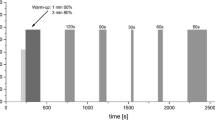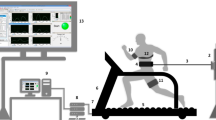Abstract
Oxygenation, measured by near-infrared spectroscopy (NIRS), in inactive muscles decreases during high-intensity exercise because of the decrease of oxygen supply. However, there have been few reports regarding recovery of inactive muscle oxygenation after exercise. This study was performed to examine reoxygenation in the biceps brachii muscle (BB) after supramaximal cycling exercise. Six active young male volunteers (age: 22 ± 3 years, peak oxygen uptake (VO2peak): 53.8 ± 5.4 mL/kg/min, mean ± S.D.) performed warm-up exercise, followed by cycling exercise at 140% of VO2peak for 30 s and then at 0 watt for 4 min (recovery exercise). Tissue oxygen saturation (StO2) in the vastus lateralis muscle (VL) and BB was monitored by spatially resolved NIRS throughout the test. The decrease rate of StO2 during exercise was 24.7 ± 7.5 p.p. in VL and 15.1 ± 8.2 p.p. in BB (N.S.). StO2 in VL increased immediately after the end of exercise, but StO2 in BB decreased continuously for 12.7 ± 7.8 s after exercise. Moreover, the time of half-recovery from the minimum to peak values after exercise was significantly (P < 0.05) longer at StO2 in BB (39.5 ± 12.2 s) than VL (25.2 ± 6.0 s). These results suggest that the recovery of microvascular oxygen supply and blood flow in inactive muscles does not start immediately after exercise.
Access this chapter
Tax calculation will be finalised at checkout
Purchases are for personal use only
Similar content being viewed by others
References
Hamaoka T, McCully KK, Quaresima V et al (2007) Near-infrared spectroscopy/imaging for monitoring muscle oxygenation and oxidative metabolism in healthy and diseased humans. J Biomed Opt 12:062105
Broxterman RM, Ade CJ, Craig JC et al (2015) Influence of blood flow occlusion on muscle oxygenation characteristics and the parameters of the power-duration relationship. J Appl Physiol 118:880–889
Hansen J, Thomas GD, Harris SA et al (1996) Differential sympathetic neural control of oxygenation in resting and exercising human skeletal muscle. J Clin Invest 98:584–596
Osawa T, Kime R, Katsumura T et al (2010) Effects of acute hypoxia on the inflection point of muscle oxygenation. Adv Exp Med Biol 662:385–390
Osawa T, Kime R, Hamaoka T et al (2011) Attenuation of muscle deoxygenation precedes EMG threshold in normoxia and hypoxia. Med Sci Sports Exerc 43:1406–1413
Shiroishi K, Kime R, Osada T et al (2010) Decreased muscle oxygenation and increased arterial blood flow in the non-exercising limb during leg exercise. Adv Exp Med Biol 662:379–384
Tanaka H, Shimizu S, Ohmori F et al (2006) Increases in blood flow and shear stress to nonworking limbs during incremental exercise. Med Sci Sports Exerc 38:81–85
Ogata H, Arimitsu T, Matsuura R et al (2007) Relationship between oxygenation in inactive biceps brachii muscle and hyperventilation during leg cycling. Physiol Res 56:57–65
Mense S, Stahnke M (1983) Responses in muscle afferent fibres of slow conduction velocity to contractions and ischaemia in the cat. J Physiol 342:383–397
Ichimura S, Murase N, Osada T et al (2006) Age and activity status affect muscle reoxygenation time after maximal cycling exercise. Med Sci Sports Exerc 38:1277–1281
Maeda S, Miyauchi T, Sakane M et al (1997) Does endothelin-1 participate in the exercise-induced changes of blood flow distribution of muscles in humans? J Appl Physiol 82:1107–1111
Nagasawa T (2008) Oxygen consumption in nonexercising muscle after exercise. Int J Sports Med 29:624–629
Author information
Authors and Affiliations
Corresponding author
Editor information
Editors and Affiliations
Rights and permissions
Copyright information
© 2017 Springer International Publishing AG
About this chapter
Cite this chapter
Osawa, T., Shiose, K., Takahashi, H. (2017). Delayed Onset of Reoxygenation in Inactive Muscles After High-Intensity Exercise. In: Halpern, H., LaManna, J., Harrison, D., Epel, B. (eds) Oxygen Transport to Tissue XXXIX. Advances in Experimental Medicine and Biology, vol 977. Springer, Cham. https://doi.org/10.1007/978-3-319-55231-6_35
Download citation
DOI: https://doi.org/10.1007/978-3-319-55231-6_35
Published:
Publisher Name: Springer, Cham
Print ISBN: 978-3-319-55229-3
Online ISBN: 978-3-319-55231-6
eBook Packages: Biomedical and Life SciencesBiomedical and Life Sciences (R0)




